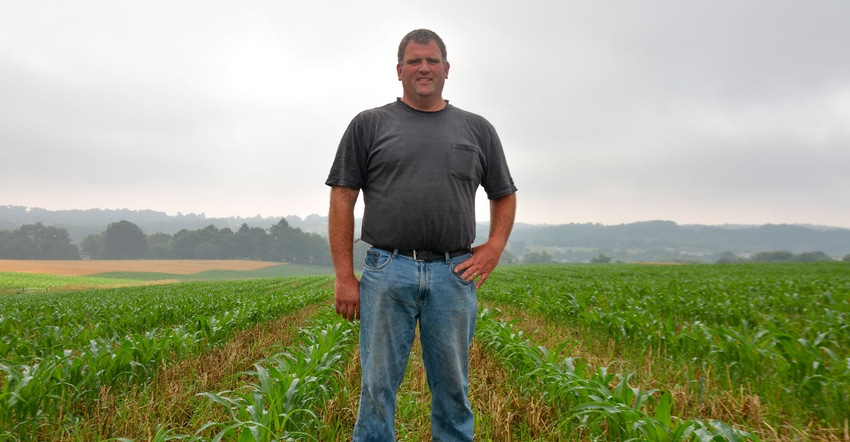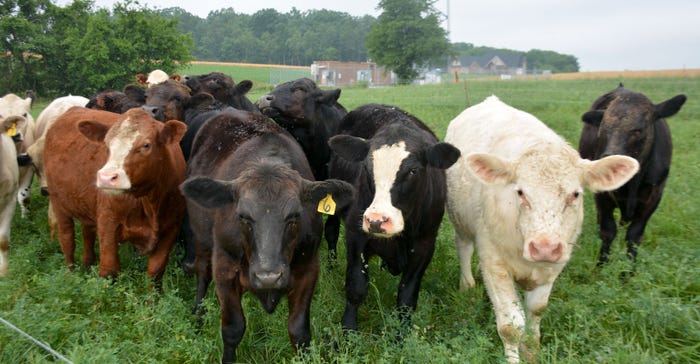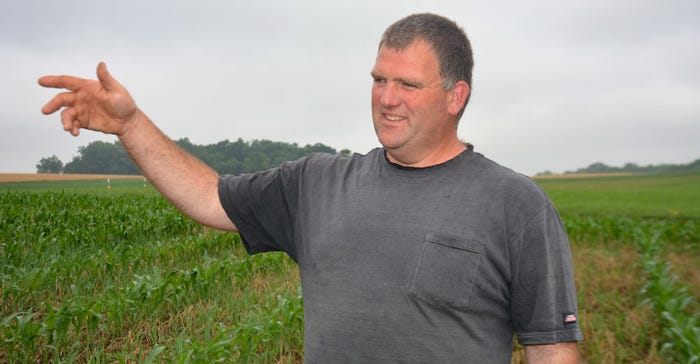
On his 1,100-acre farm in St. Thomas, Pa., Ben Peckman is doing something different this year; perhaps something crazy.
He’s trying his hand at 60-inch corn rows.
"It does look interesting,” he says, looking at the 12 acres of 60-inch corn he planted on Memorial Day.
For most farmers, the idea of growing corn in wide rows goes against the grain, no pun intended. Narrower rows — 20 inch or even 15 inch — are becoming more popular as growers push higher yields and thicker canopies to shade out weeds over summer.
Peckman, though, has other plans. He wants a cover crop established with his corn so when it’s time to harvest in the fall, he’ll have something for his 16 beef feeders to munch on before winter.
“If you plant something in October, yeah it will usually green up nice, but it doesn't get big enough to feed much. And so that's why I was interested in this system," he says.
How he did it
Peckman likes the idea of planting corn and cover crops on the same day. He’s tried inter-seeding cover crops in growing corn before with little success.
“But we're always a week away from a major drought,” he says, due to the shale soils on the farm. “So it can be difficult to do. And the interseeder trial five years ago just didn't work, so that left a bad taste in my mouth.”
 GOOD ESTABLISHMENT: Roughly a month after the corn was planted it’s nearly knee high. The cover crops still have a long way to go.
GOOD ESTABLISHMENT: Roughly a month after the corn was planted it’s nearly knee high. The cover crops still have a long way to go.

His was going to plant his corn — a Channel 101-day hybrid — on Memorial Day using his 12-row Case IH 1200 with row clutches.
To compensate for taking out rows, he raised his plant populations from the typical 28,000 on 30-inch rows to 40,000 and even 48,000 in some of the 60-inch rows.
But things never go as planned. His planter got a flat tire, and since it was Memorial Day no one was around to fix it. So he drilled the cover crops first. He has several mixes, including alfalfa-orchardgrass and clover-fescue.
Soon after, he went through with the planter, shutting off every other row right from the cab.
“It was kind of fun,” he says, though the row cleaners did disturb the already planted covers.
It was also challenging. Peckman says that he had to keep close track of the rows being planted in one row, then switch the rows when he came through in the opposite direction.
He applied 20 gallons of fertilizer at planting, but the row clutches don’t control where the fertilizer goes, so the covers also got a dose of fertilizer.
More than a month later, and just before sidedress time, the corn’s growing but the cover crops are showing mixed results. He planted the corn in a rye field. Since he’s growing cover crops, he couldn’t use a residual herbicide to control weeds. Pigweed has gotten established in some of the plots.
Still, compared to the 30-inch plots that were planted in early May, “this looks really good to me, I’m happy. These plants are very close to what I’m used to but they’re double the population,” he says.
Now it’s a matter of watching and waiting. If all goes well and he gets enough rainfall, he’ll combine the corn, or chop it silage, and let his feeders graze on the stover and forage.
Finding the 'sweet spot'
“I focus on the sunlight thing,” says Bob Recker, owner of Cedar Valley Innovation LLC in Waterloo, Iowa. Recker spent 41 years with John Deere as a product engineer but got interested in 60-inch corn after working with a crop consultant on farms in the Midwest. He’s become well-known for his YouTube videos on 60-inch corn.
One trend he found was that he consistently saw the outer two rows of cornfields out-yielding other areas. The reason? Recker says those plants get more sunlight due to not being blocked by another row.
He began toying with wider corn rows by establishing plots on Midwest farms. With wider rows, the corn gets a lot more room to harness the sun and possibly grow more ears. But the tradeoff is an overall hit to production.
Jim Hershey, a farmer in Elizabethtown, Pa., has tried wide-row corn for two years on a small plot on his farm. Being that he grows corn for grain, he’s not sold on the idea as it cuts into his overall production. One thing he did was raise his populations from 32,000 to 48,000 in the wide rows. He also selected a hybrid with more of a flex ear.
Hershey doesn’t graze animals, so the idea of establishing a cover crop isn’t an important selling point.
But this is the sweet spot for 60-inch corn, according to Recker. That extra sunlight between the rows will, theoretically, allow for better establishment and growth of cover crops.
“The folks that graze, they will get value off that secondary or companion crop; they can take a little hit,” he says.
 GRAZING GOALS: With cover crops established alongside his corn, Peckman hopes to have enough cover to allow his feeder cattle to graze this fall.
GRAZING GOALS: With cover crops established alongside his corn, Peckman hopes to have enough cover to allow his feeder cattle to graze this fall.

In plots he’s grown in past years, Recker says that 60-inch corn, at least statistically, does as well as 30-inch corn. You won’t see a yield bump, but you usually don’t see a big yield hit, either.
“You have to start with the desire to have cover crops. The corn part is relatively easy. It's especially easy if you have an electric-drive planter because you can turn rows on and off and adjust pops right from the cab,” Recker says.
Weeds, though, are what he calls the “900-pound gorilla” in the system.
“If you’re aren’t already in a pretty good place as far as controlling weeds,” he says. “You shouldn’t look at it unless you have an established base of covers.
“The message is start small and experiment. Challenges are weeds, that is the No.1, and chemical carryovers, be mindful of that. Also, social pressures from neighbors. You really kind of want to have a long view.”
Seeking the right covers
When it comes to cover crops, Recker says to start with something simple.
“My default is oats. You really have to be thinking about this about a year ahead of time. Make sure you have herbicides that don’t have a big carryover,” he says.
Tracey Neff, an agronomist at King’s Agriseeds in Lancaster, Pa., is looking at legume cover mixes with protein in his 60-inch plot. One mix is a clover mix that includes yellow blossom sweetclover; another is winter wheat and red clover; and a third is a mix of alfalfa and berseem clover.
 WAITING FOR RESULTS: While he’s encouraged by the growth of the corn, Peckman is holding is breath that the cover crops will go enough this summer for a good grazing season this fall.
WAITING FOR RESULTS: While he’s encouraged by the growth of the corn, Peckman is holding is breath that the cover crops will go enough this summer for a good grazing season this fall.

The winter wheat, he says, doesn’t vernalize and won’t produce a seed head, but it can act as a nurse crop for the clover.
“The whole idea is how to get it to grow on a large scale. It’s trying to see what mix is the best to establish, what can possibly work,” he says.
At the Penn State research farm in Rock Springs, Pa., Sjoerd Duiker, professor of soil management, is also testing three different mixes in a 60-inch corn plot: 5 pounds orchardgrass and 15 pounds of alfalfa; 15 pounds of alfalfa and 5 pounds berseem clover; and 50 pounds of wheat and 15 pounds of red clover.
He planted a Red Tail RT54T13, a 104-day, Roundup Ready, full flex hybrid. The plant populations were 30,000 in a comparable 30-inch plot and 45,000 in the 60-inch plot.
“This is my first year for wide row. I'm really interested in this concept of intercropping," he says.
Unlike Peckman, Duiker planted the corn first and waited to go through with an interseeder. The cover crops were small seeds planted a half-inch deep. One concern is whether there will be enough seed to soil contact to get the crops established.
 FROM THE CAB: Peckman planted his 60-inch rows by turning off every other row unit. It wasn’t easy. He had to switch what rows to shut off when planting from the opposite direction
FROM THE CAB: Peckman planted his 60-inch rows by turning off every other row unit. It wasn’t easy. He had to switch what rows to shut off when planting from the opposite direction

The project is also comparing 30-inch plots with and without cover crops to see possible reductions in yield and the differences in cover crop establishment.
“There are many things we need to figure out,” he says. Should you plant cover crops with corn or wait to plant? How do you handle weeds? How do you fertilize? Will it be beneficial to graze animals in fall?
“I see this as being something that is interesting for the smaller farmers," he says.
Waiting for results
The biggest downside for Peckman is not being able to spray a residual herbicide.
“There are pluses and minuses both ways," he says. “We were trying to do it as cheap as possible this year.”
He’s also nervous about how the clover and alfalfa will look in November once corn is ready to be combined.
“What is the clover and alflalfa going to look like? I’m concerned about that. It's going to be a little past mature, so will it be nutritious enough?” he says. "Basically we're in a wait and see. I frankly don't see any downsides yet, but we'll let you know.”
About the Author(s)
You May Also Like






